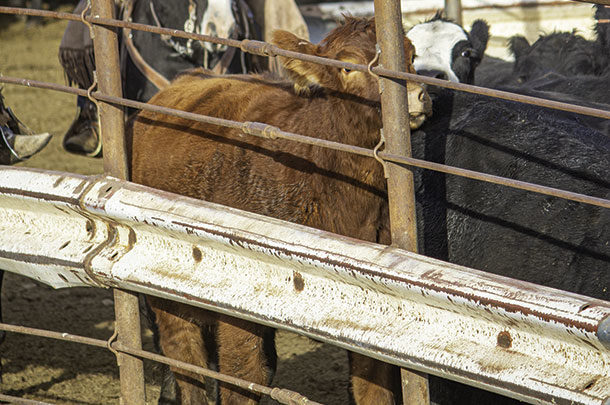Temperatures have cooled off, days are shortening and many producers are in the throes of weaning and preparing to ship this year’s calf crop, marking it officially fall. While the main focus for the cow-calf producer will likely be the process of weaning calves to precondition or for immediate shipping, the feedyards are preparing for the high influx of cattle, which includes handling “shipping fever.”
Bovine respiratory disease (BRD), or simply pneumonia, is one of the most common as well as costliest problems the cattle industry encounters. It is estimated to cost the industry approximately $3 billion annually. BRD can also be a common cause of death for nursing calves over the age of three weeks. In a 20-year study, the USDA Agricultural Research Service’s Meat Animal Research Center tracked the annual incidence of BRD in pre-weaned calves and found an average of 11% morbidity. Additionally, the mortality rate was 13% in these affected pre-weaned calves.
Once a calf has been afflicted with BRD, there are both immediate as well as long-lasting effects on performance, such as weighing less at weaning compared to unaffected calves. These negative effects can then extend to the feedyard and to the rail.
Feed intake and conversion of calves affected by BRD will be poorer compared to healthy cattle. That poor performance results in carcasses that have decreased marbling scores and lower quality grades. This will mean reduced income for producers who retain ownership or who market on a grid.
BRD can be very complex due to exposure to infectious agents, stress and environmental factors all combining to create a perfect storm that instigates the issue. So what can be done on the front end at the ranch level to help mitigate the issue?
Start with your vet
J.W. Wood – general manager at Agri Beef Company, Boise Valley Feeders – encourages producers to develop a good working relationship with your veterinarian. “Working with your veterinarian to create a quality vaccination protocol for branding and weaning helps set those calves up to perform when they do reach the feedyard environment.”
When creating a vaccination protocol, it important to understand there are several viruses involved with BRD, which include bovine viral diarrhea, infectious bovine rhinotracheitis, bovine respiratory synctial virus and parainfluenza type 3 virus. This should influence which vaccines to select to prepare the calf’s immune system.
Exposure to these viruses damages the respiratory tract, which then allows bacteria, most commonly Mannheimia haemolytica and Pasteurella multocida, to colonize in the lungs. Haemophilus somnus may also be present and can cause severe damage to the heart muscles in addition to pneumonia. Mycoplasma bovis is another bacterial-type organism which, in addition to causing severe pneumonia, causes swollen, painful joints in calves. Fortunately, today we have access to vaccines that are able prevent viruses and some bacterial agents.
Wood’s suggestion of establishing a vaccination protocol at branding, where calves are vaccinated with a modified-live vaccine at about two months old, will help calves create an initial immune response to BRD. Ideally, calves should be given a second dose of the vaccine prior to marketing, as calves that have received the second dose experience less BRD in the feedyard. The second dose continues to help build the calf’s immunity prior to the stressful events of weaning and shipping.
Stress and treatment
Stress, another factor that influences the rate of BRD, is unavoidable in the cattle industry, but our goal as producers should always be to reduce the level of stress when we can. When calves are experiencing stress, their immune system is being suppressed in response to the stressful event. A management step to consider is preconditioning calves for at least 30 days prior to shipping.
The truck ride to the feedyard on its own is a stressful event, which is then exasperated if calves were freshly weaned versus preconditioned. Further, calves that were not pre-weaned are also more likely to get sick as are those that were castrated and dehorned after shipping, stressing the importance of performing surgical procedures well before calves ship.
The preconditioning time frame also allows producers to observe calf health and address issues prior to shipping. Calves will typically display clinical signs of BRD within one to three weeks following weaning or seven to 10 days after arriving at the feedyard. While prevention is the best approach to controlling BRD, early recognition when a calf does become sick is key to improving their outcome, as well as overall performance.
Calves experiencing BRD will initially be depressed, having drooping ears, an extended head, a bowed back and will be isolating themselves from other calves. As the illness progresses, they’ll go off feed and will exhibit an increased respiratory rate, as well as potentially experiencing diarrhea, coughing, staggering and nasal discharge. Untreated, severe cases of BRD will kill calves. Calves with symptoms should be pulled and have their temperature checked; ill calves will have a fever of over 104ºF. It is recommended to temperature check prior to 10 a.m., as outside temperature will elevate the animal’s body temperature.
Treatment with antibiotics specific to pneumonia is then recommended at this point. Additionally, to help the calf respond to antibiotics, a producer could administer an anti-inflammatory drug to encourage them to go back to feed sooner. Providing a gallon of warm water with electrolytes for every 100 pounds bodyweight stimulates appetite as well as correcting dehydration. Again, consult with your veterinarian to determine the best course of action, as well as what steps to take if the first treatments are not causing an improvement.
Feed them right
Another important component of preconditioning is good nutrition, especially ensuring quality mineral supplementation to fill in nutritional gaps and help boost immunity. Nutritional deficiencies may aid in the depression of calves’ immune systems and may inhibit the efficacy of the vaccine protocol being implemented. This is a practice highly recommended by Wood: “Implementing a strong mineral program not only reduces nutritional deficiencies, it’s a management practice that complements other objectives for their herd health status.”
To continue with the goal of decreasing stress, as well as helping calves be prepared for ration changes at the feedyard, it would be encouraged to begin acclimating them to concentrate-type feedstuffs. They’ll experience less stress at the feedyard, as well as experience less digestion issues and maintain a positive direction in performance.
These are practices recommended by Wood. “We start with a clean slate upon arrival in regards to vaccination, working with our consulting veterinarian implementing the most progressive vaccination protocols. We also provide a balanced ration with immediate access to water. This helps prevent magnifying respiratory issues while working calves gradually to higher-concentrate rations. Excellent animal handling also helps in minimizing health challenges.” Finally, to limit stress, handling cattle correctly – whether during branding, weaning or shipping – is another key factor.
The final factor to consider when trying to manage BRD is environment, a factor which may be out of our control. Calves are more likely to get sick in the fall than other times of the year, due to large temperature swings from day to night, as well as dusty conditions. It is during this season that calves need to be closely monitored for early health issues.
“Respiratory illness is the costliest disease in the yard, so the more we can minimize the issue across the board, the better for all parties. Not only does the feedyard benefit, but it allows the feedyard to pay more for your calves. Sick cattle don’t perform whether in the pen or on the rail. It’s always appreciated when the cow-calf producer is also working in sync to help create the best protein source possible. When each segment of the industry is contributing to the production of healthy animals that perform well in the yard and ultimately grade exceptionally, our industry as a whole benefits,” says Wood.
This benefit then carries on to our consumers who also appreciate industry efforts to raise healthy cattle that result in a quality eating experience for them and their families.
References omitted but are available upon request by sending an email to the editor.










